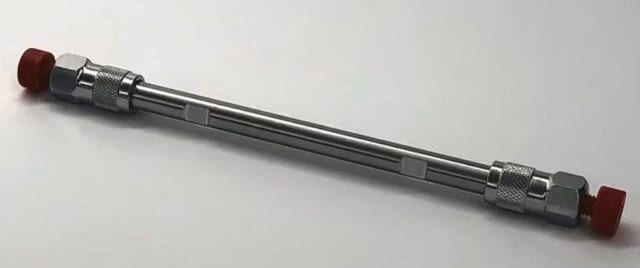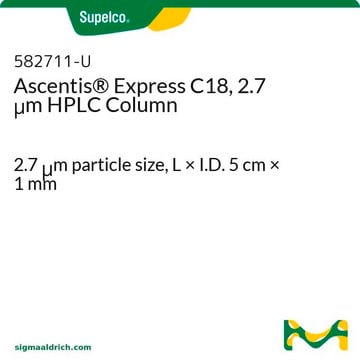The Guide to Dispersion Measurement has simple instructions on how to measure IBW and can be found at sigma-aldrich.com/express.
53569-U
Ascentis® Express 90 Å F5 (2.7 μm) HPLC Columns
L × I.D. 10 cm × 2.1 mm, HPLC Column
Synonyme(s) :
Core-shell (SPP) Fused Core PFP HPLC column
About This Item
Produits recommandés
Nom du produit
Ascentis® Express F5, 2.7 μm HPLC Column, 2.7 μm particle size, L × I.D. 10 cm × 2.1 mm
Matériaux
stainless steel column
Niveau de qualité
Agence
suitable for ISO 21675 2019
suitable for USP L43
Gamme de produits
Ascentis®
Caractéristiques
endcapped
Fabricant/nom de marque
Ascentis®
Conditionnement
1 ea of
Paramètres
60 °C temp. range
600 bar max. pressure (9000 psi)
Technique(s)
HPLC: suitable
LC/MS: suitable
UHPLC-MS: suitable
UHPLC: suitable
L × D.I.
10 cm × 2.1 mm
Superficie
135 m2/g
Impuretés
<5 ppm metals
Matrice
Fused-Core particle platform
superficially porous particle
Groupe de la matrice active
PFP (pentafluorophenyl) phase
Taille des particules
2.7 μm
Dimension de pores
90 Å pore size
pH de fonctionnement
2-8
Application(s)
food and beverages
Technique de séparation
reversed phase
Vous recherchez des produits similaires ? Visite Guide de comparaison des produits
Description générale
Application
- Interference of Preservatives on Urinary Iodine Measurement by Sandell-Kolthoff Method.: This research examines the impact of preservatives, including hydrochloric acid, on the accuracy of urinary iodine measurements. The study highlights the need for careful selection of preservatives to avoid analytical interference (Kaya et al., 2022).
- Monitoring the Extraction of Copper from Chicken Dung Leachate Using an Aluminium Electrode as an Indicator.: The study explores the use of hydrochloric acid in the leaching process of copper from chicken dung. It demonstrates the effectiveness of hydrochloric acid in extracting metals from organic waste materials (Kugeria et al., 2019).
- Development of an Analytical Method for Urocanic Acid Isomers in Fish Based on Reactive Extraction Cleanup and Chaotropic Chromatography Techniques.: This paper details a method using hydrochloric acid for the extraction and analysis of urocanic acid isomers in fish. The method enhances the detection and quantification of these compounds in biological samples (Zhong et al., 2018).
- Determination of Single-Ion Activities of H+ and Cl- in Aqueous Hydrochloric Acid Solutions by Use of an Ionic Liquid Salt Bridge.: The research provides a novel approach to determining the activities of hydrogen and chloride ions in hydrochloric acid solutions using an ionic liquid salt bridge, contributing to the understanding of ion behavior in aqueous solutions (Sakaida et al., 2011).
Informations légales
Vous ne trouvez pas le bon produit ?
Essayez notre Outil de sélection de produits.
Application
Colonne de garde
Nécessaire, mais non fourni
Produit(s) apparenté(s)
Code de la classe de stockage
11 - Combustible Solids
Classe de danger pour l'eau (WGK)
WGK 3
Point d'éclair (°F)
Not applicable
Point d'éclair (°C)
Not applicable
Faites votre choix parmi les versions les plus récentes :
Certificats d'analyse (COA)
Vous ne trouvez pas la bonne version ?
Si vous avez besoin d'une version particulière, vous pouvez rechercher un certificat spécifique par le numéro de lot.
Déjà en possession de ce produit ?
Retrouvez la documentation relative aux produits que vous avez récemment achetés dans la Bibliothèque de documents.
Les clients ont également consulté
Articles
A significantly improved HPLC-fluorescence method for DMB-NANA and -NGNA, and application of this method to compare 2 candidate biosimilar therapeutic proteins to their respective RMs.
This Sigma-Aldrich article continues to detail new methodology for the analysis of Vitamin D metabolites using HybridSPE-Phospholipid technology.
This article evaluates different phase chemistries for stationary phases in Hydrophilic Interaction Liquid Chromatography (HILIC) and uses multivariate analysis for classification based on chemical modification.
Enhanced selectivity for stereoisomers and closely related compounds with alternate selectivity from C18 phases for basic, acidic, or neutral compounds
Protocoles
LC/MS Analysis of Opioid Glucuronide Metabolites in Urine on Ascentis® Express F5 after Solid Phase Extraction (SPE) using Supel™-Select HLB
Fast and Accurate LC-MS Analysis of Vitamin D Metabolites, Using Ascentis® Express F5 HPLC Columns from Supelco®
Contenu apparenté
FAS, or 'forever chemicals,' persist in the environment and pose risks to human health. Discover our environmental monitoring tools for PFAS quantification, aiding researchers, regulators, and labs in testing for PFAS.
Les FAS, ou "substances chimiques éternelles", persistent dans l'environnement et présentent des risques pour la santé humaine. Découvrez nos outils de surveillance environnementale pour la quantification des PFAS, qui peuvent aider les chercheurs, les organismes de réglementation et les laboratoires à tester les PFAS.
Chromatograms
application for HPLCapplication for HPLCapplication for HPLCapplication for HPLCAfficher plus-
How can I measure my instrument bandwidth (IBW) and determine what columns can be used with minimal efficiency loss created by too much internal instrument volume?
1 answer-
Helpful?
-
-
Is there anything special I need to do to my HPLC system to use Ascentis® Express F5 HPLC Columns?
1 answer-
Nothing special is required to use Ascentis® Express F5 HPLC Columns. To obtain the full benefits of Ascentis® Express Columns, one should minimize dispersion or instrument bandwidth in the HPLC system (tubing, detector flow cell) as well as confirm the detector response system is set at a fast level. For more information, request Guidelines for Optimizing Performance with Ascentis® Express HPLC Columns (T407102).
Helpful?
-
-
What flow rate should I use with Ascentis® Express F5 HPLC columns?
1 answer-
Based on the minimum in the van Deemter curves, higher flows than 5um particle columns are required in order to maximize Ascentis® Express F5 HPLC column efficiency. The suggested starting point for flow rate for Ascentis® Express columns: 1.6 mL/min for 4.6 mm ID; 0.8 mL/min for 3.0 mm ID; and 0.4mL/min for 2.1 mm ID.
Helpful?
-
-
Can Ascentis® Express F5 HPLC columns be used for LC-MS?
1 answer-
Yes, Express Fused-Core™ particles were designed with LC-MS in mind. Even extremely short column lengths exhibit sufficient plate counts to show high resolving power. The flat van Deemter plots permit resolution to be maintained at very high flow rates to maximize sample throughput. All Ascentis stationary phases have been evaluated for MS compatibility during their development, and the Express phases are no exception. You can expect extremely low column bleed and background while maintaining longest possible column lifetime. A bonus of Ascentis® Express F5 HPLC Columns for high throughput UHPLC and LC-MS are that they are extremely rugged and highly resistant to plugging, a very common failure mode for competitor columns.
Helpful?
-
-
Can I use Ascentis® Express F5 HPLC Columns on any type of HPLC system?
1 answer-
Ascentis® Express F5 HPLC Columns HPLC columns are capable of use on standard HPLC systems as well as UHPLC systems. These columns are packed in high pressure hardware capable of withstanding the pressures used in UHPLC systems.
Helpful?
-
-
What is the Department of Transportation shipping information for this product?
1 answer-
Transportation information can be found in Section 14 of the product's (M)SDS.To access the shipping information for this material, use the link on the product detail page for the product.
Helpful?
-
-
Can I use Ascentis® Express F5 HPLC Columns on a UHPLC system?
1 answer-
Ascentis® Express F5 HPLC columns are packed in a way making them suitable for these ultra high pressure instruments. In fact, Ascentis® Express F5 HPLC Columns outperform sub-2 μm micron columns on many applications since Ascentis® Express F5 HPLC Columns provide the benefits of sub-2 μm particles but at much lower back pressure. These benefits include the capability of providing fast HPLC and higher resolution chromatography. The Fused-Core particle consists of a 1.7 μm solid core and a 0.5 μm porous shell. A major benefit of the Fused-Core particle is the small diffusion path (0.5 μm) compared to conventional fully porous particles. The shorter diffusion path reduces axial dispersion of solutes and minimizes peak broadening.
Helpful?
-
-
Are guard columns available for Ascentis® Express F5 2.1 mm ID HPLC Columns?
1 answer-
Yes, we have guard columns available for Ascentis® Express F5 HPLC Column . Product 53500-U is the Ascentis® Express Guard Holder and Product 53594-U Ascentis® Express F5 Guard Cartridge is a package of three guard cartridges, 2.7 μm particle size, L 5mm × I.D. 2.1 mm .
Helpful?
-
-
What is the pressure rating for Ascentis® Express F5 HPLC Columns?
1 answer-
Ascentis® Express F5 HPLC Columns are stable to operating pressures up to 600 bar (9000 psi).
Helpful?
-
-
What is the carbon load for Ascentis® Express F5 HPLC Columns?
1 answer-
Carbon load which is commonly referred to as %Carbon is misleading and not meaningful for Ascentis Express. Since Fused-Core™ particle is unique in the sense that it has a solid core and porous shell, the %Carbon number can not be compared to traditional porous particles. The carbon coverage for Ascentis® Express F5 HPLC columns is 3.5 micromoles/meter-squared.
Helpful?
-
Active Filters
Notre équipe de scientifiques dispose d'une expérience dans tous les secteurs de la recherche, notamment en sciences de la vie, science des matériaux, synthèse chimique, chromatographie, analyse et dans de nombreux autres domaines..
Contacter notre Service technique









